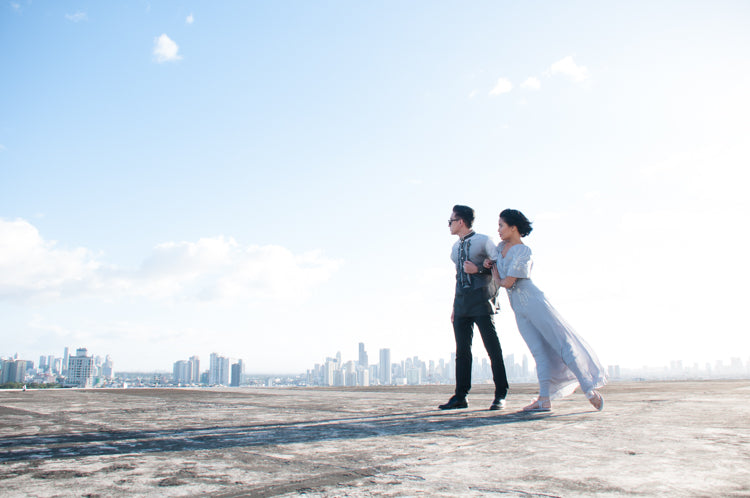The Barong Tagalog is a traditional Filipino clothing that dates back to the pre-colonial era. The name was only coined during the early Spanish colonization period. It points to the garment’s origin and distinguishes it from the three-piece suits of the Europeans. Barong Tagalog was derived from the phrase “Baro ng Tagalog,” which means “outfit of the Tagalog.”
What is Barong Tagalog
The Barong Tagalog is a sheer, lightweight garment made of piña fabric or jusi material, which is banana silk. It’s often cream-colored and hand-embroidered, and more lightweight compared to the stuffy basic black tuxedo or suit.
Piña is the most desired material for the Barong Tagalog. It’s a handwoven fabric made of pineapple fibers. The process to produce this material is tedious and time-consuming, which makes it precious and delicate. The Aklanons of Western Panay are recognized as the pioneers in piña weaving.
The first part of the meticulous process is peeling the skin of the red Visayan pineapple (ananas comosus) leaves. They do this using a shard of Chinese porcelain. They extract bastos by hand, which is a lustrous rough fiber used for making strings or twine.
Liniwan, the ivory white and fine fiber, is then extracted using a coconut shell. It goes through the degumming process, which involves rinsing, beating, and air-drying several times.
Once dried, the strands are knotted to create long threads for weaving. It takes a few weeks to produce just enough fabric for one Barong Tagalog.
Where did the Barong Tagalog originate
Despite its unassuming demeanor and subtle elegance, the barong is a magnificent wearable artwork that exudes pride and is rich with history.
Over four centuries ago, the first wearers of the barong during the pre-colonial era were the Tagalogs of Luzon. They wore a baro made of rough cotton called canga. The garment is a fitted sleeve-doublet with no collar and extends a little bit below the waist.
The color of the canga that people wore was based on their social rank: chiefs and warriors wore red, while ordinary folks wore black or white. It is also said that the well-off wore cangas made of fine linen or Indian muslin and accessorized with saluales, a colored cloth that they would hang between their legs.
Although the canga differs from the barong that we know today, the canga has qualities of the modern Barong Tagalog for men -- loose, had wide sleeves, and no cuffs.
How did the Barong Tagalog evolve
Farmers, vendors, stonemasons, and other commoners wore camison or camiseta as their everyday wear, while the Spaniards in the 1700s wore dressy shirts that had standing collars. This later on influenced the barong that the upper class and Ilustrados (the educated Filipinos) wore.
An Ilustrado during the Spanish colonial period would be seen wearing a barong with a high Elizabethan collar that had lace trimming, and embellished with a big button or a gem. This version of the barong extends just above the knees, worn with a thin sash that goes high across the waist, and paired with loose trousers. The men would wear this jusi Barong Tagalog during special Sunday Masses, fiestas (feast days in the towns), and tertullas (afternoon tea parties).
In the 19th century, the barong was given a more romantic look by hand-embroidering patterns all over the traditional Filipino clothing. It also had a smaller collar and was buttoned at the chest. The regular folks would wear it as a loose shirt paired with trousers, while others would accessorize with a black hat during special occasions. The barong eventually became monochromatic and evolved to have a closed-neck collar, and worn with a narrow, black cravat.
Various barong styles emerged after Filipino Nationalists clashed with the Spanish and then the Americans. The ruffled collars and cuffs were brought back, barongs were made of jusi and sinamay of different colors, and various patterns such as flowers and stripes became prominent. The Ilustrados wore barongs with more intricate embroidery designs to rebel against the injustices against the Filipinos during the Spanish regime.
Wealthy mestizos (Filipinos with foreign ancestry) would wear their barong with black leather pointed shoes and a bowler hat to flaunt their wealth. The barong that we know today is said to take after this style.
A new style of barong was born in the 1920s. It’s made of rengue abaca fiber and worn over a camisa de chino (a collarless t-shirt inspired by Chinese traditional fashion). It is deemed as the “most authentic” Barong Tagalog because it is the most common style used today.
Who popularized the Barong Tagalog
As American culture dominated during the Commonwealth, the men favored the suit or tuxedo over the barong. Despite that, this traditional Filipino clothing was not completely forgotten.
The “Commonwealth Barong Tagalog” emerged during the time of the late President Manuel L. Quezon, which he wore during the inauguration of the Philippine Commonwealth on November 15, 1935. This version of the barong had the Commonwealth flag with the red, white and blue stripes, as well as the American flag. It had an inner pocket on the left side, and was shorter compared to the previous barong styles.
President Ramon Magsaysay wore a barong during his inauguration and all other formal affairs, which gave the traditional Filipino clothing a new meaning -- it became a symbol of pride and honour. He made the Barong Tagalog fashionable, which the succeeding presidents emulated. President Ferdinand Marcos even recognized the Barong Tagalog as the national attire through Proclamation No. 1374.
Today, the Barong Tagalog has become accessible to Filipinos of all social classes, and has evolved into different styles to suit various occasions. There are colored barongs suitable for themed events, and even short-sleeved office barongs made of linen or cotton for corporate employees.
The Barong Tagalog has stood the test of time and remains to be the go-to formal wear for significant events because of its simple and timeless design, which leaves room for innovation. It’s amazing how the traditional Filipino clothing went through several centuries and countless evolutions -- even up to today.


Share:
Iconic Filipino Home Décor Must-haves
Textile Art and the Abra Weaving Tradition